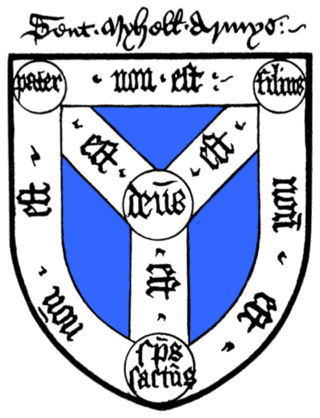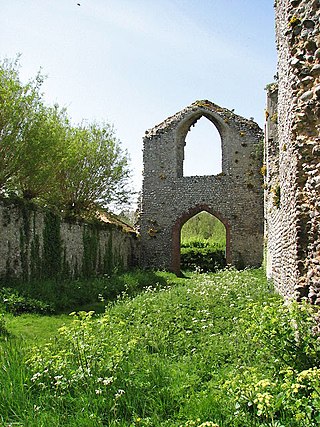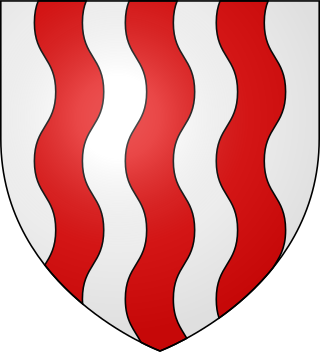Related Research Articles

Wymondham Abbey is the Anglican parish church for the town of Wymondham in Norfolk, England.

Leiston Abbey outside the town of Leiston, Suffolk, England, was a religious house of Canons Regular following the Premonstratensian rule, dedicated to St Mary. Founded in c. 1183 by Ranulf de Glanville, Chief Justiciar to King Henry II (1180-1189), it was originally built on a marshland isle near the sea, and was called "St Mary de Insula". Around 1363 the abbey suffered so much from flooding that a new site was chosen and it was rebuilt further inland for its patron, Robert de Ufford, 1st Earl of Suffolk (1298-1369). However, there was a great fire in c. 1379 and further rebuilding was necessary.

Thetford Priory is a Cluniac monastic house in Thetford, Norfolk, England. Founded in 1103 by Roger Bigod of Norfolk, Thetford was one of the most important monasteries of East Anglia.

The Holy Trinity Priory, also known as Christchurch Aldgate, was a priory of Austin canons founded around 1108 by the English queen Matilda of Scotland near Aldgate in London.

Hickling is a village and a civil parish in the English county of Norfolk. The village is 22 miles south-east of Cromer, 20.3 miles north-east of Norwich and 137 miles north-east of London. The village lies 3 miles east of the Broadlands town of Stalham. The nearest railway station is at Worstead for the Bittern Line which runs between Sheringham, Cromer and Norwich.

Mettingham College was a monastic college in the parish of Mettingham in the English county of Suffolk. The college was located within Mettingham Castle, although it was founded elsewhere.

Sibton Abbey, an early Cistercian abbey located near Yoxford, Suffolk, was founded about 1150 by William de Chesney, High Sheriff of Norfolk and Suffolk. A sister house of Warden Abbey, near Bedford, Bedfordshire, Sibton Abbey was the only Cistercian abbey in East Anglia. It was dissolved in 1536.

The Priory of St Mary in the Meadow, also known as Beeston Priory is a former Augustinian Priory, located in the village of Beeston Regis, Norfolk, United Kingdom.

Caldwell Priory was a priory of Canons of the Holy Sepulchre in Bedfordshire, England, from circa 1154 to 1536. It was situated in the south-west of Bedford on the south bank of the River Great Ouse.

Aldeby Priory was a 12th-century Benedictine monastic house in Aldeby, Norfolk, England.

Weybourne Priory was a small Augustinian medieval monastic house in Weybourne, Norfolk, England.
Blythburgh Priory was a medieval monastic house of Augustinian canons, dedicated to the Blessed Virgin Mary, located in the village of Blythburgh in Suffolk, England. Founded in the early 12th century, it was among the first Augustinian houses in England and began as a cell of St Osyth's Priory in Essex. Although it acquired a conventual life of its own, its community was always small and in some respects maintained dependency upon the parent house. It was earmarked for closure by Cardinal Wolsey during the late 1520s but survived his fall and continued until dissolution in 1536.

Butley Priory, sometimes called Butley Abbey, was a religious house of Canons regular in Butley, Suffolk, dedicated to The Blessed Virgin Mary. It was founded in 1171 by Ranulf de Glanville, Chief Justiciar to King Henry II (1180-1189), and was the sister foundation to Ranulf's house of White canons (Premonstratensians) at Leiston Abbey, a few miles to the north, founded c. 1183. Butley Priory was suppressed in 1538.
Campsey Priory,, was a religious house of Augustinian canonesses at Campsea Ashe, Suffolk, about 1.5 miles (2.5 km) south east of Wickham Market. It was founded shortly before 1195 on behalf of two of his sisters by Theobald de Valoines, who, with his wife Avice, had previously founded Hickling Priory in Norfolk for male canons in 1185. Both houses were suppressed in 1536.

Flixton Priory was a nunnery under a prioress following the Augustinian rule, which formerly stood in the parish of Flixton in the north of the English county of Suffolk, about 3 miles (4.8 km) south-west of Bungay. It was founded by Margery de Creke in 1258, and was dissolved in 1536–37. It was the poorest of the nunneries within the Diocese of Norwich. The site of the priory, which was enclosed by a moat, was at the present Abbey Farm, where little apart from the position in the landscape and a small section of standing wall remain to be seen. It was scheduled as an ancient monument in 1953. It is privately owned and is not open to the public. It is suggested that some parts of the masonry may have been re-used in St Peter's Hall at St Peter, South Elmham.
Snape Priory was a priory in Suffolk, England. It was founded as a cell of the Benedictine St John's Abbey, Colchester in Essex.
Stoke-by-Clare Priory was a Benedictine monastery in Stoke-by-Clare, in Suffolk, an alien priory, dependent on Bec Abbey, in Normandy. Reinstituted in 1124, the Priory was suppressed in 1415.

de Valognes is a family name of two distinct powerful families with notable descendants in the centuries immediately following the Norman Conquest. Although a connection between them has been inferred by some authorities, this is not supported by positive evidence.
References
- 1 2 3 "Houses of Austin canons: The Priory of Hickling". British History Online. Retrieved 6 October 2012.
- ↑ R. Mortimer, 'The Family of Rannulf de Glanville', Bulletin of the Institute of Historical Research 54 (1981), pp. 1-16, at pp. 7-9.
- ↑ 'The Valognes Fee', in W. Farrer and C.T. Clay, Early Yorkshire Charters, Vol. 5: The Honour of Richmond, Part 2 (reprint), (Cambridge University Press, 2013), pp. 234-37 (Google).
- ↑ For texts of foundation charters, see W. Dugdale, Monasticon Anglicanum, New Edition, Vol. 6 part 1 (James Bohn, London 1846), pp. 475-76 (Google).
- ↑ T.D. Hardy (ed.), Rotuli Litterarum Clausarum Vol. II: MCCXXIV-MCCXXVII (Eyre & Spottiswoode, London 1844), p. 157b (Mecklenburg Verpommern). Correctly "Hacheston", not "Hasketon" as in V.C.H.
- ↑ A. Jessopp (ed.), Visitations of the Diocese of Norwich, A.D. 1492-1532, Camden Society New Series XLIII (1888), pp. 25-27 (1492), 125 (1514), 173-74 (1520), 211-13 (1526), & 277-78 (1532) (Internet Archive).
- ↑ "Hickling Priory". English Heritage. Retrieved 5 October 2012.
- ↑ "Priory Farmhouse and Outbuildings/Hickling Priory". Historic England. Retrieved 12 June 2022.